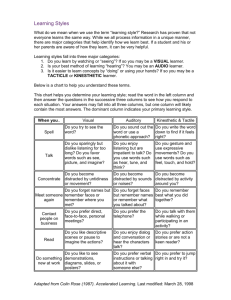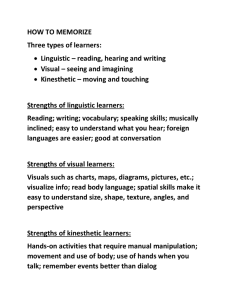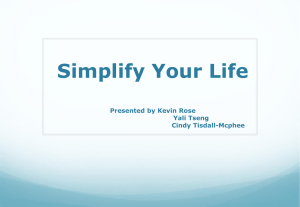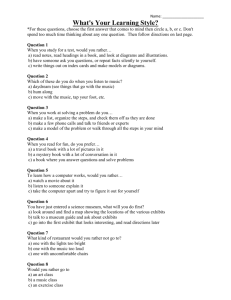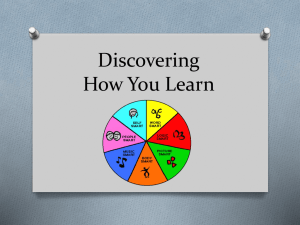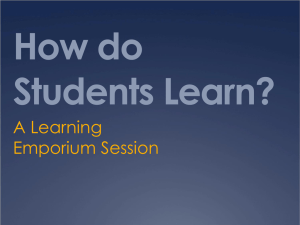Sensory Preference Self Test
advertisement
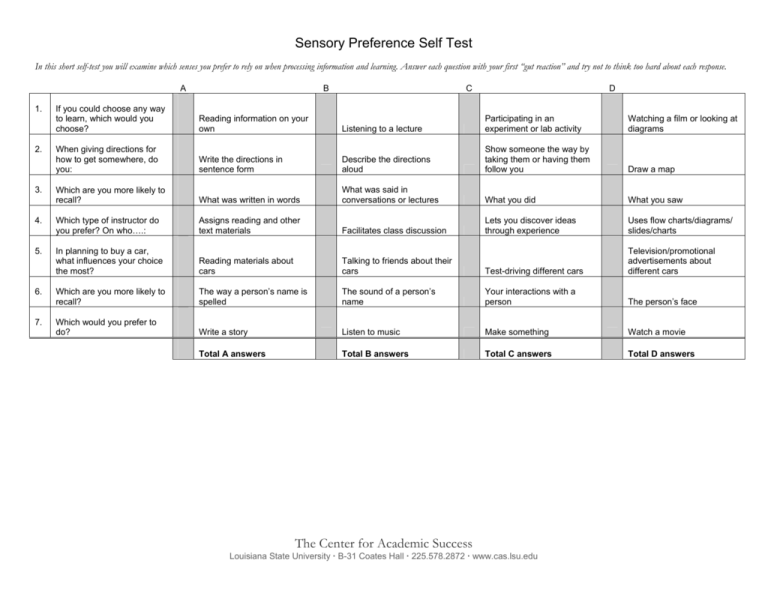
Sensory Preference Self Test In this short self-test you will examine which senses you prefer to rely on when processing information and learning. Answer each question with your first “gut reaction” and try not to think too hard about each response. A 1. 2. 3. 4. 5. 6. 7. B C D If you could choose any way to learn, which would you choose? Reading information on your own Listening to a lecture Participating in an experiment or lab activity Watching a film or looking at diagrams When giving directions for how to get somewhere, do you: Write the directions in sentence form Describe the directions aloud Show someone the way by taking them or having them follow you Draw a map Which are you more likely to recall? What was written in words What was said in conversations or lectures What you did What you saw Which type of instructor do you prefer? On who….: Assigns reading and other text materials Facilitates class discussion Lets you discover ideas through experience Uses flow charts/diagrams/ slides/charts In planning to buy a car, what influences your choice the most? Reading materials about cars Talking to friends about their cars Test-driving different cars Television/promotional advertisements about different cars Which are you more likely to recall? The way a person’s name is spelled The sound of a person’s name Your interactions with a person The person’s face Which would you prefer to do? Write a story Listen to music Make something Watch a movie Total A answers Total B answers Total C answers Total D answers The Center for Academic Success Louisiana State University B-31 Coates Hall 225.578.2872 www.cas.lsu.edu Results Reading/Writing (Higher score on Column A) The more read/write answers you chose, the more likely you learn best through reading or writing. Therefore, read all assignments. Focus on headings and subheadings to help you find the author's organization of information. You might find it useful to reread and rewrite words and notes. Use flashcards, lists, and charts to study. Listening/Aural (Higher score on Column B) The more aural answers you chose, the more likely you learn best by listening. You might think that you should tape your lectures, but that won't help you separate and organize important lecture ideas. Instead, try converting written lecture notes to audio tapes. To do so, you first review and edit your notes to identify the main ideas and important details. Then read your notes aloud into a tape recorder, leaving brief amounts of time between main ideas and questions. This gives you time to think and study. Participation in study groups and class discussions also provide ways to learn from what you hear. Interactive/Kinesthetic (Higher score on Column C) The more kinesthetic answers you chose, the more likely you learn by direct experience. When you learn from direct experience, you learn by touch or by physical movement. The more you do, the more you learn. Highlighting, underlining, labeling information, and writing add movement to learning. Mapping, charting, or creating other graphics also are ways to learn by doing. Role-plays, models, and experiments also help you learn actively. Participation in study groups or tutoring others provide additional ways to become an active learner. Visual/Sight (Higher score on Column D) The more visual answers you chose, the more likely you learn visually. Visual learners prefer flash charts, visual outlines or maps, and graphics. Adding meaningful symbols, colors, and graphics to notes also provide visual cues. Try to visualize how information appears on a page. In study groups or discussions, focus on how people look when they speak. The Center for Academic Success Louisiana State University B-31 Coates Hall 225.578.2872 www.cas.lsu.edu Sensory Preference Information We learn through all of our senses, but generally favor one or two. We process visually (through images, color and form), aurally (by hearing and sound), kinesthetically (by moving and manipulating) and through formal text processing (through reading and writing.) Here are your results: Visual/Sight: Visual learners prefer seeing what they are learning. Pictures, images, graphs and colors help them understand ideas and mentally organize information better than explanations. A drawing may help more than a discussion about the material. When someone explains something to a visual learner, he or she may create a mental picture of what the person talking describes. Visual learners prefer to study with charts, visual outlines or other images. Adding meaningful symbols, colors, and graphics to notes provide visual cues. Try to visualize how information appears on a page. Visual learners are more shape and form-oriented. Formal text-oriented people depend more on words or numbers in their images. Listening/Verbal/Aural: Auditory learners prefer spoken messages. Some auditory learners need to hear their own voice to process the information, but others process information through listening to others speak in lectures and small groups or discussions. They can attend aurally to details, translate the spoken word easily into the written word, and are not easily distracted in their listening ability. Auditory learners will benefit from converting written lecture notes to audio tapes. To do so, you first review and edit your notes to identify the main ideas and important details. Then read your notes aloud into a tape recorder, leaving brief amounts of time between main ideas and questions. This gives you time to think and study. Auditory learners will benefit from regularly attendance in classes and participation in study groups and class discussions. Kinesthetic/Interactive/Tactile Learning: Kinesthetic learners want to sense the position and movement of what they are working on. Tactile learners want to touch. "Enough talking and looking," they may say. "Let's work with this stuff. Let's get our hands dirty already." Those preferring hands-on, kinesthetic learning gravitate toward active, sensory-motor learning. They tend to prefer "learning by doing," and may find theoretical and abstract thinking a challenge. Kinesthetic learners tend to have good motor memory and motor coordination. When you learn from direct experience, you learn by touch or by physical movement. The more you do, the more you learn. Most college teaching relies more on traditional formal text learning. But kinesthetic learners can integrate more interaction by highlighting, underlining, and labeling information. Try mapping, charting, or creating other graphics along with using role-playing, models, and experiments to help you learn actively. When using flash cards place them on the ground and organize them in meaningful groups. Buy a roll of large “butcher paper” and hang it on your walls for processing/mapping and drawing out information you are trying to learn. Place it in different areas of your room for different topics. Participation in study groups or tutoring others provide additional ways to become an active learner. Formal Text Processing (Reading and Writing) Most college courses use this as the dominant mode of learning. You are required to do a significant amount of reading and writing in order to be successful in most college classes. If this is your dominant style you find it natural to process material by reading, taking notes, and organizing your material on paper (or on a computer) through traditional formats such as outlines and written or typed text. To maximize your learning experience, continue with the basics: preview, then read all assignments, focus on headings and subheadings to help you find the author's organization of information. Use flashcards, lists, and charts to study. In addition, be sure to challenge yourself to integrate other modes of processing (mapping, study groups, etc.) to enhance and balance your learning experience. The Center for Academic Success Louisiana State University B-31 Coates Hall 225.578.2872 www.cas.lsu.edu Sensory Preference Comparison Visual/Sight (prefers pictures, charts, diagrams, graphs, etc.) Listening/Aural • In Class Underline important points Highlight with different colors Use symbols, charts and graphs Attend lectures, discussions and tutorials Tape lecture for later • • Create lists and headings Take complete lecture notes • • • • (prefers hearing information) Reading/Writing (prefers reading or writing about information) • • • • • • • • • • Interactive/Kinesthetic (prefers moving, touching, visualizing movement or hands-on activities to learn information) • • Use all senses in class Labs- field trips • • • • • While Studying Underline notes and text Highlight notes and text (colors) Summarize with images Discuss material in study group Summarize notes, then read out loud Read onto tape, then listen back • • • • • ID key words and associate them with details Reread notes and text and summarize them in writing Reread and summarize old tests Answer (in writing) the review questions • Trial and error is important can learn from mistakes Create personal examples Use pictures to illustrate notes Stand, move, walk Study in an exam-like environment • • The Center for Academic Success Louisiana State University B-31 Coates Hall 225.578.2872 www.cas.lsu.edu • • • During Exams Recall pictures Draw concept map of essay “Dump” formulas and diagrams Listen to your inner voice to recall information Talk out question under breath Use key words to trigger more complete answers At the beginning of the exam, write out important lists Essay – write thesis, then outline Use Information Matrix to help organize Remember examples Stretch or move to jog memory
